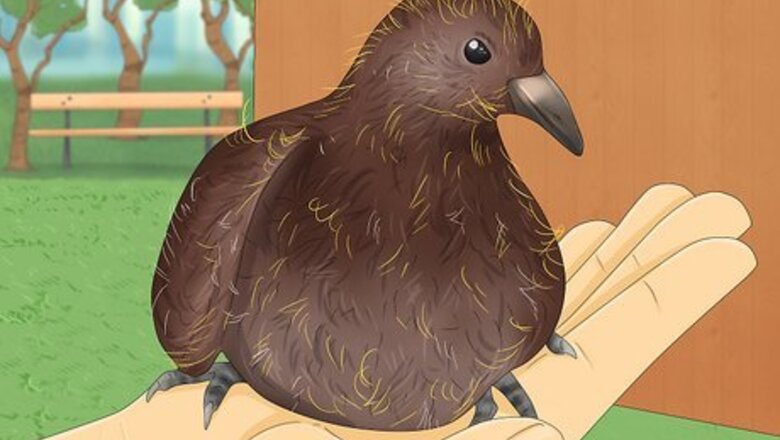
views
Choosing Your Pigeons
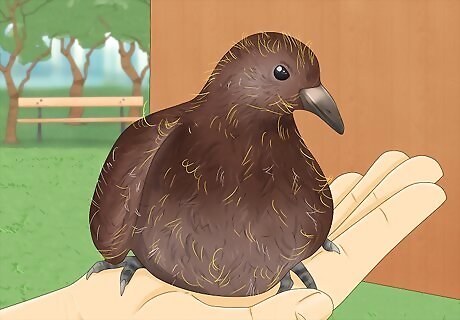
Adopt or buy young birds for easier taming. The younger your birds, the more quickly they'll adjust to you and your home. Younger birds will only ever be familiar with you and your space, and they shouldn't have to overcome any bad experiences with previous owners. Mature domesticated pigeons should eventually learn to trust you as well, but they may require a little more time and patience.
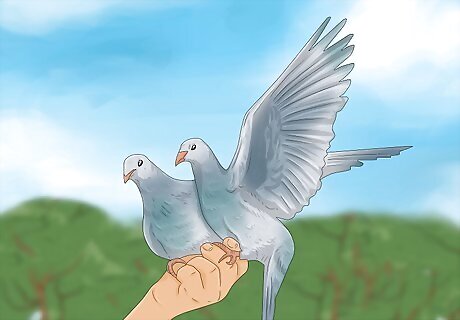
Pick pigeons in pairs or groups to keep your birds happy. Pigeons are extremely social birds who need constant companionship. If your pigeons choose to court and mate, they'll be together for life. Plan on keeping at least two birds. If you have room, consider creating a small flock of four to six pigeons. If you end up with a mated pair, you may need to keep the pigeons from breeding. Female pigeons lay eggs every month. Once they've laid two eggs, remove the eggs and replace them with warmed-up wooden eggs. Both pigeons will continue to sit on the wooden eggs until they realize they won't hatch. Destroy the real eggs by leaving them outside for other animals to eat. This process will need to be repeated each month. If your female bird is sitting on a fake egg, it won't continue to lay eggs. Laying eggs too often can result in calcium deficiency and death. Any female bird can lay eggs, though without a male bird they will be infertile. You can find fake eggs online. For example, try https://theeggshop.com/.
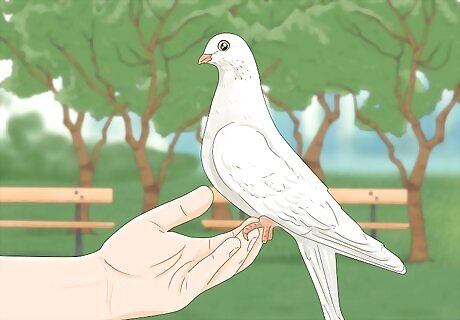
Adopt your pigeons to save homeless pets. There are many domesticated pigeons without homes located at animal or bird shelters and rescues. While adopting may not allow you to choose the exact age or breed of pigeon that you'd like, you'll be helping out a bird in need. Adoption is also a generally less expensive option than purchasing birds through breeders. Most adoption services will cover any initial vet bills. They sometimes also allow you to foster your birds to see if you make a good match. Adopting may provide you with birds that either require more time before they're tamed, or that never become fully comfortable being touched or handled by you. Be ready to spend lots of time building trust.
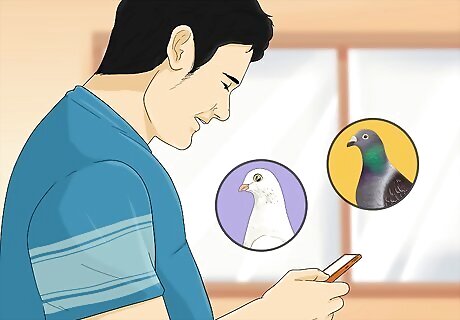
Find a breeder online to buy a specific type of pigeon. Find reputable breeders by contacting them directly. Ask how long the breeder has been operating, and see if they'd be willing to send photos of their facility to make sure their birds are well treated. Breeders can allow you to choose younger birds, or racing, homing, and other types of unique pigeons. They'll also be able to provide you with a pair of birds that's used to spending lots of time with people. Birds from breeders may be ready to be handled more quickly than rescued birds. However, they'll likely cost more than rescued birds.
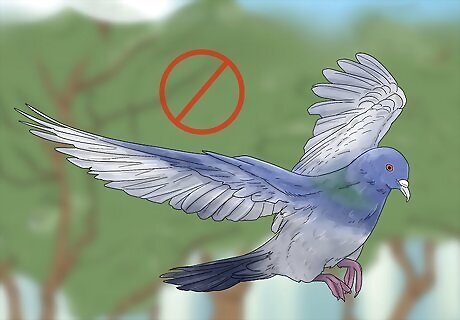
Avoid adopting wild pigeons. If you find a lost or injured wild pigeon, take the bird to a wildlife rescue that won't kill the bird. While wild pigeons may eventually become comfortable as pets, they'll likely never be as tame as domesticated pigeons. It's also not fair to the wild bird to prevent it from enjoying its previous lifestyle. Before you take the pigeon to the rescue, call the facility to be sure they're prepared to care for and then safely release the pigeon. You can find a map of bird-safe rescues located in the United States here: https://www.pigeonrescue.org/resources/some-pigeon-dove-friendly-rescues-in-the-us/ Most animal rescues will not kill the bird unless it is beyond saving or has a low quality of life.
Preparing Your Home for Your Pigeons
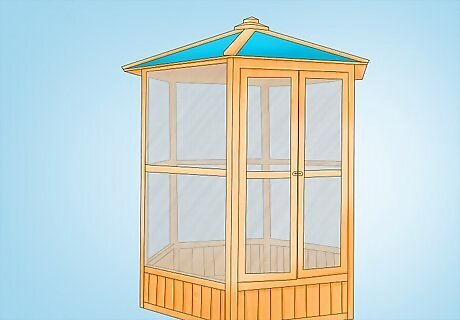
Build a large and safe aviary for outdoor birds. Unlike indoor birds who can be let of of their cages, outdoor pigeons will be spending all of their time inside the aviary to keep them safe from predators. For 2-4 birds, create a 7-foot (2.13-m) by 4-foot (1.22-m) space that's at least 6-7 feet (1.83-2.13 m) high. Make a solid, sloped roof to keep out the weather and provide a “attic” for roosting. You may want to leave a small area of the roof exposed to the elements by covering it just with your wildlife-proof mesh. This will brighten up your aviary and allow your pigeons to play in the rain. Enclose the sides of the aviary in wildlife-proof mesh with with openings of an half-inch (1.27 cm) or less. Pigeons prefer long, rectangular spaces that make it easier for them to fly around. Avoid circles or hexagons. Note that some larger types of pigeons, such as King Pigeons, require outdoor aviaries.
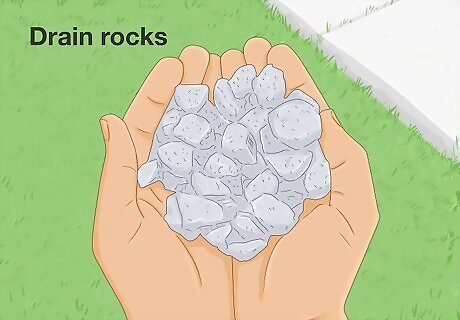
Make your aviary easy to clean by laying down drain rock. Line your aviary floor with cement and 1.5-inch (3.81-cm) drain rock. A covering of drain rock will make it simple for you to clean your aviary. You'll need to clean pigeon poop off cement or wooden floors daily, while drain rock can be hosed down or raked every week or so. The rocks and pebbles need to be larger than 1.5 inches (3.81 cm) to keep your birds from swallowing them. A cement floor is crucial for keeping out digging predators. If you can't lay down cement, line the floor with hardware mesh with openings of an half-inch (1.27 cm) or less. Your mesh will need to be covered with earth or drain rock to protect your birds' feet.
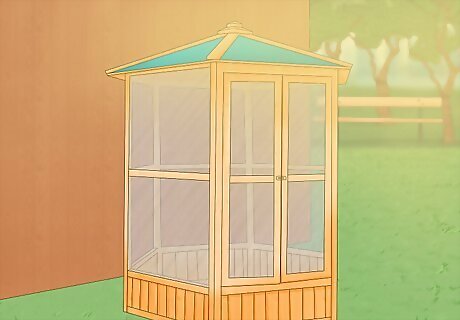
Locate your aviary in a sunny outdoor area. Place your aviary in a spot where it can benefit from plenty of sunshine, as pigeons love the light. Since pigeons do coo and make some noise, ask your neighbors where they'd be most comfortable with the aviary. This will keep you from becoming your neighbors' new worst enemy.
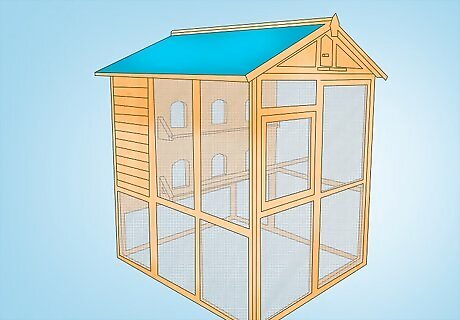
Choose a spacious and safe cage for indoor birds. Two birds require a cage that's no smaller than 42 inches (106.68 cm) wide, 27 inches (65.58 cm) deep, and 30 inches (76.2 cm) high. Cover the bottom of the cage with a pigeon-friendly and easy-to-clean liner, such as a plastic or yoga mat that's cut to size. Widely-spaced bars will work for cages in homes without other pets, but you'll need thinly-spaced bars that keep out snouts and teeth if you have other furry critters in your home. Pigeons usually require 1/2 inch (1.27 cm) to 5/8 inch (1.59 cm) bar spacing because they have small heads (they shouldn't be able to stick their heads out between the bars). Good cage liners also include newspapers or bird litter.
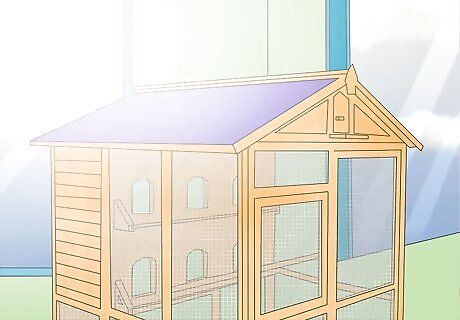
Locate your cage away from fumes and near natural light. Pigeons have poor vision in low light, and indoor spaces will always be dimmer than the outdoors. Locate your cage in an area that gets plenty of sunshine and that receives additional lighting from a mounted full spectrum light. Keep the cage away from the kitchen to prevent the birds from inhaling any damaging cooking fumes, and don't smoke, light candles, or use air fresheners inside your home. Be sure to avoid cooking with Teflon or non-stick pots and pans, as these give off toxic fumes that could injure or kill your birds.< If you can't mount a full spectrum light in the room where your birdcage is located, place a full spectrum lamp near, but not directly next to your birdcage.
Teaching Your Pigeons to Trust You
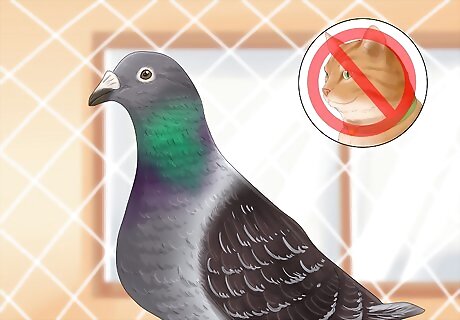
Stay patient with new birds as they adjust to your home. Most birds will need about a week to get used to their new space. Keep their environment quiet during this time, and ensure that you and everyone else in your family give the birds the time and space they need during this adjustment period. Keep pets away from the cage or aviary to avoid traumatizing your new birds. It may be a good idea to keep young children away from your new pigeons during the first week or so. Children may not fully understand why they have be quiet or calm around the birds, and this may cause the birds to think they're predators.
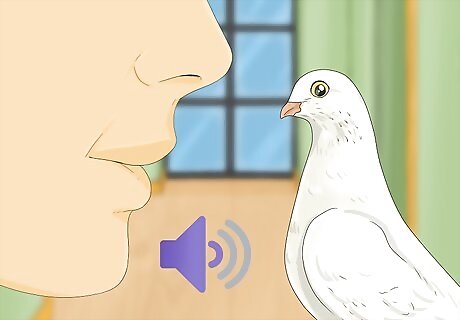
Keep your movements and voice calm around your pigeons. As your pigeons get used to you and their new home, it's important that they don't become scared of you. Keep your hands behind your back whenever you approach the cage, and avoid sudden movements. Speak, sing, or coo softly to the birds to comfort them and make them familiar with the sound of your voice.
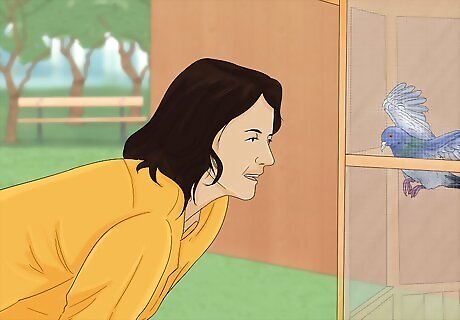
Spend time near your birds' cage or aviary to introduce yourself. As your birds begin to become more comfortable with your presence, spend more time with them. If your birds are still hiding or cowering when you're near their enclosure, give them more time. If not, study or read next to their cage or aviary for a few hours each day.
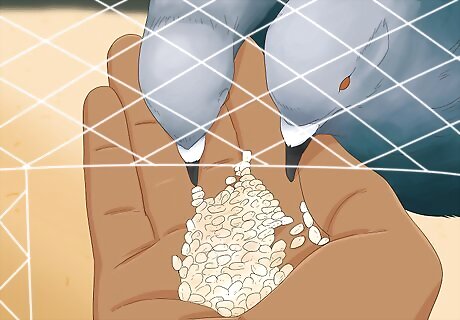
Feed your birds treats while they're in their enclosures. Reach through the bars or wire mesh of the birds' cage or aviary to provide treats. At first, simply place the treats on the ground. This will let the birds know that you're a source of food and care. Slowly, the birds should begin to take treats directly from your hands. Stay outside of their enclosure the first few times you do this. The security of the cage or aviary will let the bird know they're safe. Once they've eaten out of your hands a few times, either open the cage door or let yourself into the aviary to feed them more directly.
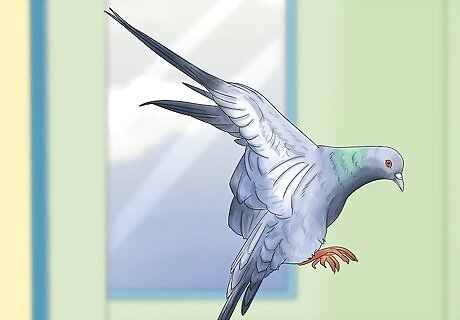
Let indoor birds explore your home once they're comfortable. Once your indoor birds are responding to your presence and eating out of your hand, they're probably ready to be allowed out of their cage. Indoor birds need to spend time outside of their enclosure daily to keep their minds and bodies healthy, so start this process as soon as you feel the birds are ready. If you're worried about getting pigeon poop in your house, use pigeon diapers, also known as pigeon pants. They're adorable and practical. Clipping the birds' wings could make it easier to tame them and may be safer because the birds will be less likely to fly into ceiling fans, walls, or out-of-doors. However, some consider this practice to be inhumane.
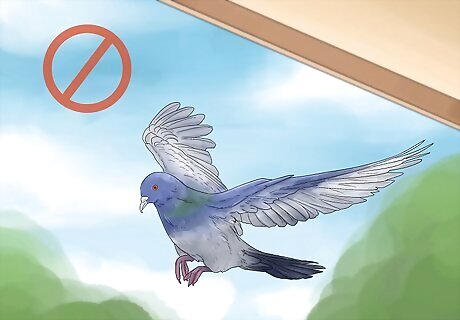
Avoid free-flying any domesticated pigeons. Neither indoor or outdoor pigeons should be let outside for free flights. Once they're domesticated, they're extremely vulnerable to attacks from predators. Pigeons protect themselves in flocks in the wild, and your pair or small group of birds will be unable to do this. Your birds also may not be able to find their way back to your home if they fly too far away.
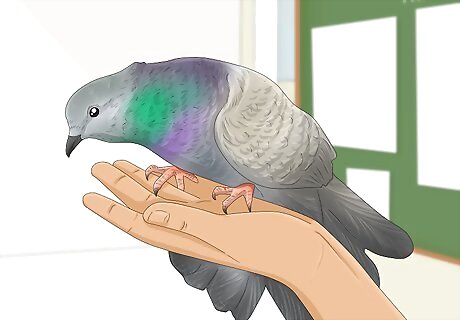
Let your birds come to you. Allow your birds to set the pace of your relationship. Rather than reaching for the birds or picking them up, let them hop into your hands. This will keep the birds from getting scared of you, which could cause setbacks in the taming process. Eventually, your birds should become affectionate and playful.
Providing Routine Care to Your Pigeons
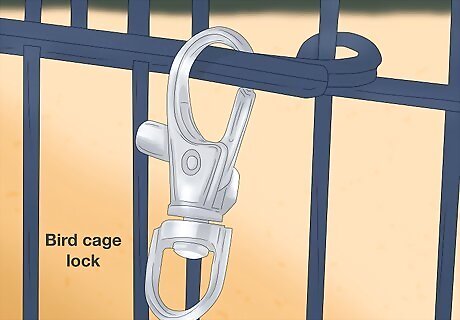
Keep your birds safe from other pets and predators. Other animals pose a constant threat to your pigeons. Beyond ensuring that you've set up a cage or aviary that can fully protect your pigeons from pets and predators, be extremely careful when you close your birdcage or aviary. Use a carabiner to secure outdoor aviary locks, and zip-ties for indoor cages. This will keep the birds in, and pesky creatures out. You can also find bird cage locks, which are available online and in pet stores.
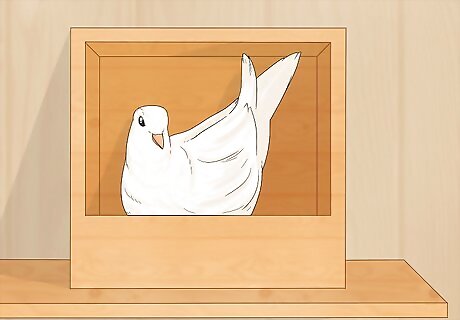
Give your pigeons shelves, perches, and mirrors. Birds need spaces and tools to both rest and play. Pigeons use shelves for lounging and perches for sitting and watching the world go by. A mirror will act as a sort of television for your birds, as they'll recognize themselves in the surface and watch their own movements. Outdoor birds will also need nesting boxes to keep them warm and dry during wet or cold weather.
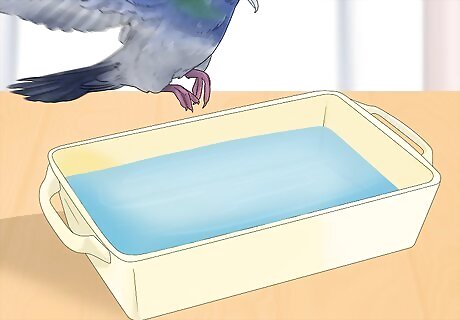
Give your pigeons a bathtub. Pigeons thoroughly enjoy bathing and playing in water. Place a large ceramic casserole dish or plant saucer filled with clean water in their aviary or cage. Change the water daily, or more frequently as needed. Healthy birds are very conscious of their cleanliness, so if your bird isn't bathing, they may not be feeling well. Mist your bird with water and see if having damp feathers inspires them to bathe. If not, contact your vet.
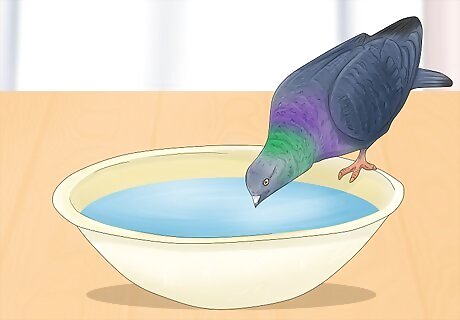
Ensure that your birds always have clean, fresh water. It's very important for pigeons to stay hydrated. Your birds should have constant access to clean water in bowls that won't tip over when they use them. Provide ceramic bowls filled with water, and change the water daily.
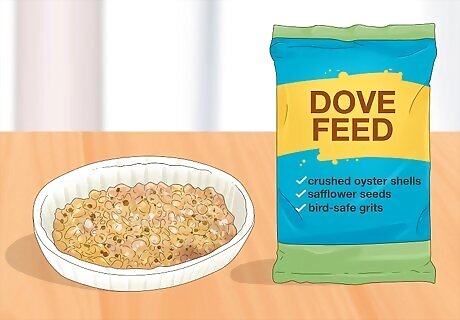
Feed your pigeons bird seed and leafy greens. Start by providing 2 tablespoons (28.36 g) per bird of pigeon-appropriate bird feed each morning. Check if any is left the next morning, and decrease by a small amount of feed each day until you've found the measurement of feed that your bird can fully consume in 24 hours. You should also provide a small bowl of chopped-up carrots, broccoli, snap peas, kale, cauliflower, and/or romaine lettuce 3-4 times per week. Good-quality pigeon or dove feeds will contain a mixture of safflower seeds, crushed oyster shells, bird-safe grits, and a few other seeds and grains.




















Comments
0 comment